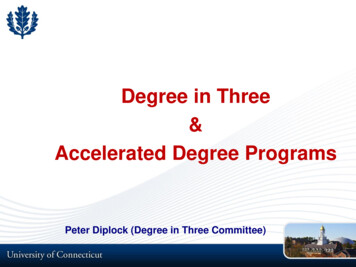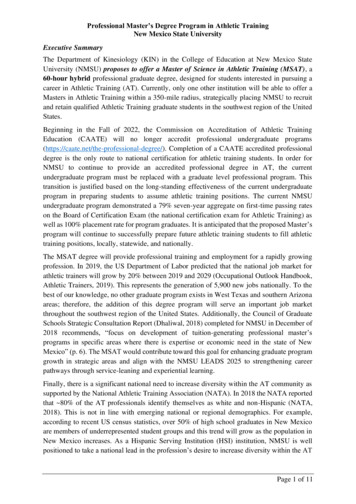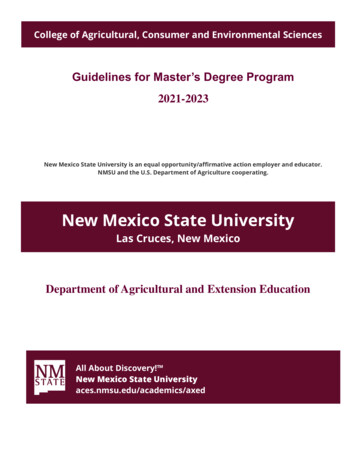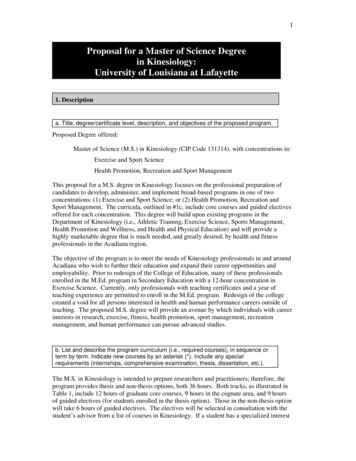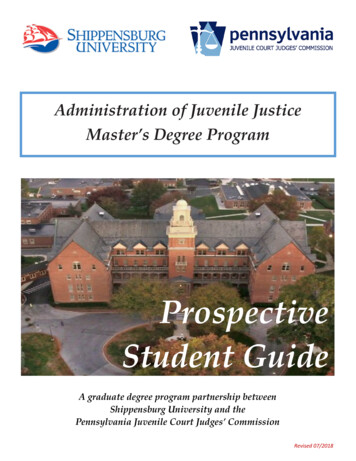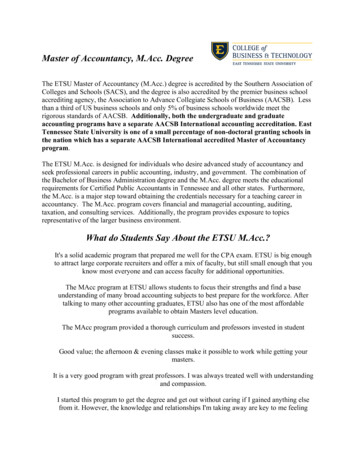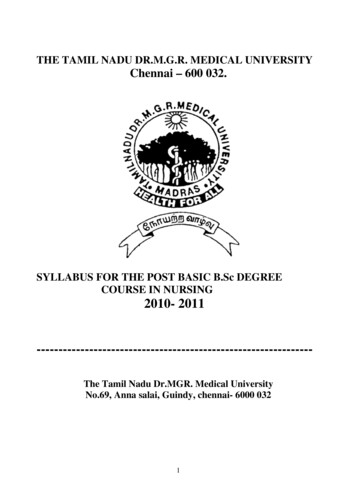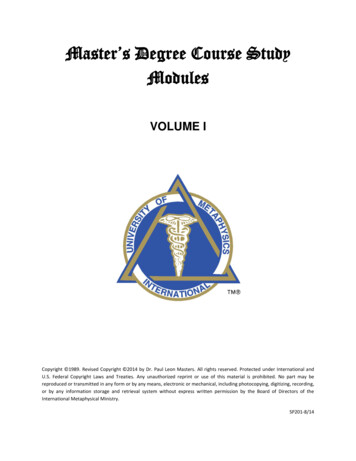
Transcription
Master’s Degree Course StudyModulesVOLUME ICopyright 1989. Revised Copyright 2014 by Dr. Paul Leon Masters. All rights reserved. Protected under International andU.S. Federal Copyright Laws and Treaties. Any unauthorized reprint or use of this material is prohibited. No part may bereproduced or transmitted in any form or by any means, electronic or mechanical, including photocopying, digitizing, recording,or by any information storage and retrieval system without express written permission by the Board of Directors of theInternational Metaphysical Ministry.SP201-8/14
Table of ContentsI.The Metaphysical Psychology of ConsciousnessPart I . 1Part II . . .8Part III – The Collective Unconscious . . .17Part IV – Yoga and the Mind . . . . .25II.Psychic-Mystical Aspects of MetaphysicsPart I . .34Part II – Life After Death . . .38Part III – Reincarnation . . . .44III.Pastoral PsychologyPart I . . .51Part II – Transference and Counter-Transference . .60i1
IThe Metaphysical Psychologyof ConsciousnessPart Ie live today in a world that is rapidly awakening to an exciting, yet age-oldconcept of the mind, and thus a new way of living. The validity of whatmystics and metaphysicians have spoken of for centuries is slowly but surelybeing proven.W Nothing can affect human life as profoundly as this new understanding ofconsciousness, which can not only keep pace with the rapid advancements ofouter technology, but potentially accelerate far beyond it. Metaphysics, considered for a long period of time as only vague, speculativephilosophy, is coming of age in a New Age of Mind. The answers thatmetaphysics has given to the age-old questions of: “Who am I?”“What am I?”“Where have I been?” and,“Where am I going?” are increasingly being accepted as reality.2 As science catches up with the truths that metaphysicians have intuitivelydiscovered and presented in the past, the answers to the questions regarding therelationship between man/woman, mind, and the universe are making moresense and finding increasing acceptance. Consider that until the middle 1960’s, the opinions of metaphysicians wereshunned by most psychologists and psychiatrists. However, with a stepped-up pace in parapsychology, the effects of meditation,experiments in biofeedback, mass exposure to Kirlian photography, and countless
mind-expansion and awareness programs nationwide, a new Psychology ofConsciousness is emerging. Contributing to this is a new awareness on the part of an increasing number ofmedical physicians. Most importantly, as metaphysical principles are being proven, philosophicaldiscussions of metaphysical knowledge need no longer be left to an esoteric few. Rather, it is becoming evident that metaphysical knowledge has a real-life role toplay in the daily mental life of all human beings. The so-called “mystical” canbecome the most practical foundation upon which to interact with life, and withothers, on a daily basis. One can receive no greater gift in life than the gift of metaphysical knowledge.As Socrates notably said, “The unexamined life is not worth living.” Inmetaphysics today, it can be said, “The examined life is far more worth living.”One can receive no greater gift in life than the gift of metaphysical knowledge. AsSocrates notably said, “The unexamined life is not worth living.” Inmetaphysics today, it can be said, “The examined life is far more worth living.” In this new world of mind, Sigmund Freud, while appreciated for his efforts, isnow being set aside. The analytical psychology of the late Carl Jung has gainedgreat popularity. And what has brought on this shift? Jung explored the teachings of mystics and metaphysicians who existedthroughout the ages, in an attempt to penetrate the deepest layers of thehuman mind. With his tremendous contribution to academic psychology, Jung ismost certainly the greatest psychologist of the twentieth century. This is in no small measure because he drew into psychology the importantteachings of metaphysics. At one time, he was quoted as saying, “What the East[where metaphysics has long existed as a religious mindphilosophy/psychology] knows about the human mind is at least 2000 yearsahead of Western psychology.”3
In Jung’s statement, we find a great truth. If one truly studiesmetaphysics to its fullest, it can be seen that most of the basic ideaspresented in metaphysics have an Eastern origin.In Jung’s statement, we find a great truth. If one truly studies metaphysics to its fullest,it can be seen that most of the basic ideas presented in metaphysics have an Easternorigin.This does not mean that the ancient Egyptian and Greek metaphysicians did not alsoadd to, or complement, Eastern metaphysics, as, of course, did the greatestmetaphysician of them all – Jesus.Yet, so many of today’s metaphysically-minded people would not be able to understandthe true meaning of Christ’s teachings, had they not been cross-referenced with theteachings of Eastern mystics.Metaphysics – A Historical Perspective Let us take a look at some of the contributors who paved the way for today’scurrent thinking and knowledge in the area of Metaphysics.Madam Blavatsky - The Psychology of New Consciousness, based on metaphysics,probably had its strongest beginnings in the United States, with the TheosophyMovement of Madam Blavatsky. Her two outstanding books, “The Secret Doctrine”and “Isis Unveiled,” laid tremendous groundwork for today’s metaphysical thinkers, asmany subsequent teachers and writers drew from her works.Mary Baker Eddy - Then along came Mary Baker Eddy, a woman who was ill a greatdeal of her life. She discovered the power of the mind and subsequent healing forherself through a hypnotist named Parkus Quimby. Later, however, she would attackhypnotism. It is believed she very likely felt it would be unpopular with the people ofher day to present “religious suggestive therapeutics” under the label of “hypnotism.”It wasn’t until she was 65 years old that Mary Baker Eddy gave her first Christian Sciencelecture. To those of us who have studied all major teachings of the mind, worldwideand throughout history, what is known today as “Christian Science” can best bedescribed as “Christianized Eastern Metaphysics.” Her interpretation of Christ’steachings was definitely along the lines of Eastern metaphysical thinking.4
Whether she had studied metaphysics, intuitively arrived at metaphysical truths, or acombination of the two, one can only speculate. Indeed, the metaphysical pantheism ofMary Baker Eddy is obvious. Christian Science became the first major metaphysicalmovement with a practical application, with major emphasis on health, of course, butalso with a strong emphasis on prosperity and improving the quality of daily living.Through Christian Science as a vehicle, the success of metaphysics spread, and otherstook up the banner of what later became known as “Truth Teachings” or “NewThought.”Charles and Myrtle Fillmore – The contributions of two wonderful and inspiring souls,in the persons of Charles and Myrtle Fillmore, were notable in that they first healedthemselves; they then went on to share with their fellow human beings what, again, canonly be described as “Christianized Eastern Metaphysics,” in the marvelous movementthat became known as “Unity.”Ernest Holmes - How much of an effect the success of the Christian Science and Unitymovements had on a man in Los Angeles, named Ernest Holmes, can only be speculated.Whatever the motivation, Holmes started the Church of Religious Science, ametaphysical teaching – again, Eastern in base.While involving the teachings of Christ, Holmes did so with less emphasis than eitherChristian Science or Unity. He made the right decision, because something happened inLos Angeles that had not been seen to any great extent in the other aforementionedmovements.What occurred was that with less emphasis on the Christian approach, sprinklings ofpeople with Jewish and other backgrounds were attracted to the teaching. This positiveaccomplishment by Holmes made it possible to bring metaphysics to people who didnot have a Christian upbringing.The teachings of Blavatsky, Eddy, and Holmes continued for years, attracting thosewho were ready for metaphysics, but not really stepping into the new arena of massmedia communications.The Beatles - Then, the phenomenon happened – the “Beatles!” This talented groupof young men, with worldwide influence over the young seeking to go beyond drugs,turned to meditation. The Maharishi – a relative unknown at that time – became theirteacher, and through his identification with them, he himself became world-renowned.5
Most important, through the mass media exposure during thatperiod, meditation became a daily practice in the lives of so manypeople. A new phenomenon was emerging – the public, en masse,was being exposed to metaphysics. Most important, through the mass media exposure during that period, meditationbecame a daily practice in the lives of so many people. A new phenomenon wasemerging – the public, en masse, was being exposed to metaphysics. The mind-body relationship of Western psychology became the mind-body-spirit, ormetaphysical, relationship.Self-Help Jose Silva - The social atmosphere was now set for people like Jose Silva topromote his Silva Mind Control on a large scale. Here, under the “Self-Help” label,people were exposed to a combination of self-hypnosis, meditation, and psychicsensitivity techniques.The “Self-Help” and “Awareness” labels created acomfortable doorway to metaphysics for the more skeptical, conservative soulsamong us. Werner Erhard – He saw the “handwriting on the wall” and realized that the “Self-Help/Awareness” label was the way to reach people, and thus, EST and other similarmovements appeared on the scene.Rev. Ike - At the same time, black consciousness came alive to the basics ofmetaphysical consciousness through the personage of “Rev. Ike.” Probably more thanany other teacher mentioned here, Rev. Ike was criticized because of his emphasis onhow metaphysics could be used to create prosperity.My Methods - Meanwhile, contributing in my own way, I was saturating newspapers inthe Los Angeles area with large display advertising (continually for a period of fouryears), presenting what I call “Meditation Dynamics.”This combinationmeditation/self-hypnosis/self-help approach to life has, as its goal, consciousness ofmetaphysical principles of the mind.I mention this here because all my activity during that time was aimed at people in LosAngeles, California, and not nationally in any direct way. Those who live in another partof the country or outside the United States may not be aware that Los Angeles is wheremost movements and/or ideas generally get started. If people are influenced in Los6
Angeles, that influence will spread throughout the country. For this reason, my personalefforts were concentrated there.Many people studying with me during that period had never heard of metaphysicsbefore we met, and yet today they are metaphysical teachers. We were so successful inthis regard through the National Metaphysics Institute, that a Higher EducationalDivision was formed, the University of Metaphysics, to give Doctoral Degreerecognition to graduates wishing to teach metaphysics. At this point, we shifted fromlarge, local advertising to more extensive national publicity.Additional MetaphysiciansThose metaphysicians discussed above, whose influence has been strongly felt in this field,are fairly well-known by the general public. Many who are not as renowned have alsocontributed to bringing greater metaphysical awareness to the public. Listed below are a few metaphysicians who stand out, each with his or her ownunique contribution:Swami Vivekananda - Brought Jnana Yoga teachings in Vedanta form to this countryaround the beginning of the nineteenth century. No teacher I have ever read has taughtmore powerfully.Paramahansa Yogananda - Started the Self-Realization Fellowship in Los Angeles; histeachings reached many throughout the country via mail order studies.Manly Palmer Hall - Probably wrote more books covering metaphysical subjects thanany other author.Franklin Loehr - Explored the power of prayer on plants, and thus began the idea ofpeople talking to their plants, opening a whole new level of psychic mindcommunications.Roy Eugene Davis - Former disciple of Yogananda, he has written books onmetaphysical subjects that the general public can readily assimilate.7
Marcus Bach - His books, magazine articles, and lectures have provided real insightinto metaphysics and the metaphysical movement itself.Alice Bailey - Her many books opened the door to the deeper, more occult aspects ofmetaphysics. She picked up where Blavatsky and her main followers, Annie Besant andC.W. Leadbeater, left off.Ram Dass - Formerly Dr. Richard Alpert, and onetime crony of Timothy Leary, heintroduced a positive presentation of higher awareness to the young people, that Learywith his drug orientation could not.Though blind, she wrote volumes on Metaphysical BibleInterpretation, which, at the time of this writing, are not widely known, but maysomeday have a strong impact on the Christian Church.Corinne Heline -Catherine Ponder - Her self-help books have opened the door to metaphysics for manytraditional Christian believers.The Chaneys of the Astara Movement - Their mail order lessons have reached manywho are interested in the more esoteric side of metaphysics.H. Spencer Lewis - Founder of the San Jose based Rosicrucian Order, his teachingshave probably reached more people by mail through the years than those of any otherorganization.So many come to mind, that it would take a small book to give credit to all of those whohave so richly contributed to the public’s current receptivity to, and awareness ofmetaphysics.Knowledge of the metaphysical movement is offered in this brief description, so thatyou may better grasp and cross-reference the Metaphysical Psychology ofConsciousness that follows.8
IThe Metaphysical Psychologyof ConsciousnessPart IIThe One Great TruthIn practically all metaphysical teachings, there is one basic truth throughout thatunderscores all that is said. It is the ONE GREAT TRUTH about the nature of themind, and that One Great Truth is:THERE IS BUT ONE MIND IN THE UNIVERSE.Followed by:ALL MINDS ARE INSEPARABLE FROM THE ONE GREAT MIND.Followed by:ALL SO-CALLED INDIVIDUAL MINDS ARE INDIVIDUALIZEDEXPRESSIONS OF THE ONE GREAT MIND. The definition of the One Great Mind by mystics, metaphysicians, and philosophershas been referred to in various ways, all of which essentially have the samemeaning: Universal Mind Cosmic Mind Infinite Mind Pure Mind Spirit God-Mind GodSuch knowledge has not been arrived at through the reasoning and analysis ofthe conscious mind, but by the DIRECT, INTUITIVE EXPERIENCE OF THE INNER MIND.9
At the center, or nucleus, of what, in a psychological sense, is defined as the“Unconscious,” A CONSCIOUS INNER KNOWINGNESS OF THE INFINITE REALITY OFMIND has been experienced by the truly wise throughout history. Those who have had this experience of the innermost nature of the mind havecalled it by many names: NIRVANASAMADHICHRIST CONSCIOUSNESSCOSMIC CONSCIOUSNESS-by the Buddhistby the Hinduby the Christian Mysticby the PhilosopherBy whatever name may be used to describe it, the key to understanding theworkings of the mind (and subsequently the reality of individual and collectivelife) lies in the experience of one’s innermost mind.By whatever name may be used to describe it, the key to understanding theworkings of the mind (and subsequently the reality of individual and collectivelife) lies in the experience of one’s innermost mind.Experience of the Inner Mind10 The actual meaning of being “Born Again” is in the MYSTICAL EXPERIENCE ofthis state of consciousness. An individual is mentally reborn through a DIRECTEXPERIENCE of what can only be described as a DIVINE CONSCIOUSNESS whencompared to the usual conscious life activity of the average person. The work of the Metaphysician is to bring knowledge of this Inner Mind toothers. Truly, a person can be transformed into a better, more aware, moreloving and productive individual through such an experience. All lesser practicesof metaphysics should have this inner experience as the ultimate goal. Christ explained it to his disciples this way: “Seek ye first the Kingdom ofHeaven, and all things will be added to you.” The Kingdom of Heaven, metaphysically speaking, is not an after-death place,but this Higher Inner Mind into which a person may enter and commune, andbecome One with the Infinite Mind.
Christ taught people that “The Kingdom of Heaven is here and now,”and “The Kingdom of Heaven is within you.” The Great Metaphysician, Christ, was unquestionably saying that theKingdom of Heaven is not an after-death place, but rather, a place withinyou. Christ was a teacher of meditation. He instructed his followers, “When thouprayest, enter into thy closet, shut the door behind thee, and prayethto the Father, which seeth in secret.” These words are understandable toany mystic. Enter into thy closet―Enter into your own mind. Shut the door behind thee―Shut off your outer senses to theworld around you.―Commune, or become One withHigher Universal Consciousness. Pray to thy Father whichseeth in secretMetaphysics and Traditional ChristianityAll of the above sayings are mere words taken more or less symbolically by the nonmystic and uninformed Christian traditionalist. Yet, they point to a literal practice and experience. This experience alone reveals the innermost nature of the mind and mostcompletely answers the questions of: “Who am I?”“What am I?”“Where have I been?” and,“Where am I going?” Note the following comparison between Traditional Christianity and Metaphysics inregard to these questions.11
TRADITIONAL CHRISTIANITYMETAPHYSICSTraditional Western psychology, andFreud, attempted to answer suchquestions in an ever-changing,time/space frame of reference.Metaphysics, on the other hand,gives the answers from an absoluteframe of reference.Traditional Christianity relies on theintellectualinterpretationsbytheologians of the relationship ofman/woman, mind, and theuniverse.Metaphysics says that theseanswers should come, not fromtheologians, but from within theHigher Inner Mind of an individualas a personal experience, and offersdeep meditational practices for theexperience of same.Through deep meditational practices, we actually find the nature of the mind andconsciousness. When Christ said, “In my Father’s house are many mansions,” thereference was directly to the many levels of consciousness within the human mind. Traditional Western psychology, as an example, will break down the mind very simply,as in DIAGRAM 1:Conscious LevelInstinctive DrivesTo Sexual CreativityPersonalSubConsciousInstinctive DrivesTo Self-Preservation In actually exploring the mind thoroughly in metaphysics, the mind may be broken downto the following levels, as demonstrated in DIAGRAM 2:Conscious MindPersonal SubconsciousPersonal Psychic ExchangeCollective UnconsciousPure Mind—Infinite Mind12
The experience of the innermost state of mind, or Cosmic Consciousness,provides the greatest life-transforming power in an individual’s life. Whether a Buddhist describes it as Nirvana, or a Christian mystic as God, allwho have experienced this state of mind, regardless of their seculardescriptions, agree that the experience offers the ONE ESSENTIAL IMPACTUPON HUMAN CONSCIOUSNESS that creates the greatest advancementtowards aware and healthy living, and that is one of “UNIVERSAL ONENESS.” Why, then, is this the most important of all of life’s mental experiences?
3 mind-expansion and awareness programs nationwide, a new Psychology of Consciousness is emerging. Contributing to this is a new awareness on the part of an increasing number of medical physicians. Most importantly, as metaphysical principles are being proven, philosophical discussions of metaphys

